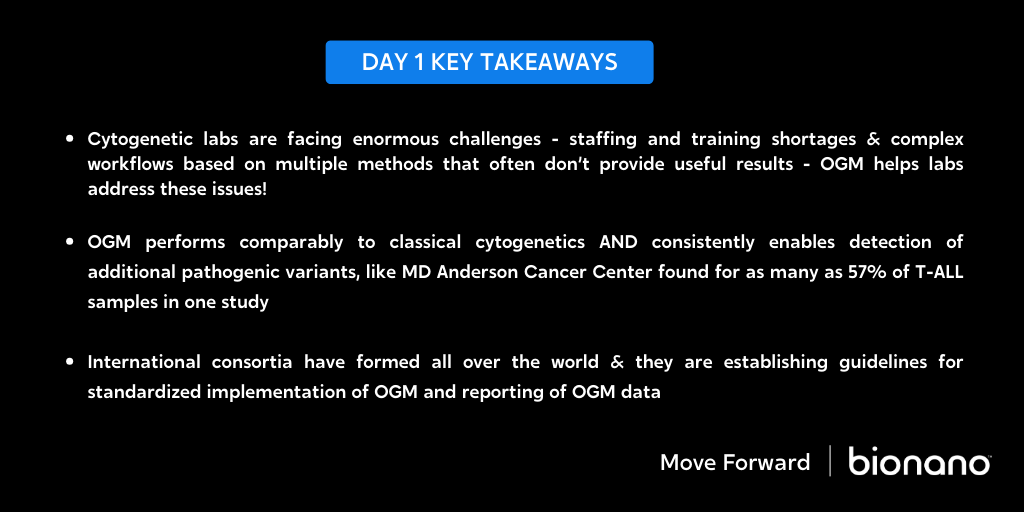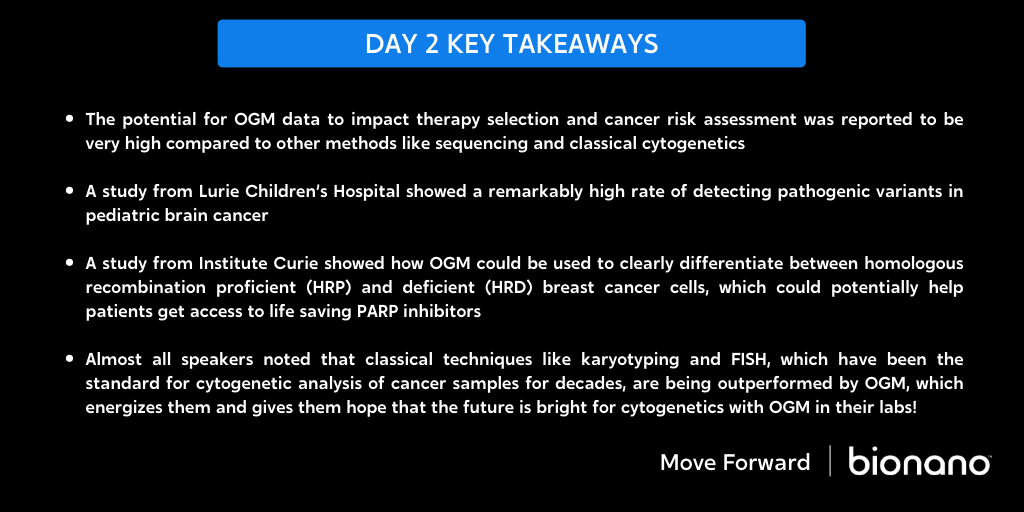Blog
Unlocking Genomic Mysteries: Bionano’s 2024 Symposium Recap

Bionano recently concluded its 2024 Symposium, a global gathering for optical genome mapping (OGM) users and the OGM-curious. Held virtually from January 22 to 25, this event showcased the strides made in the fields of cytogenetics and molecular pathology and highlighted OGM’s potential to serve as a powerful alternative to classical cytogenetic methods and a strong complement to next-generation sequencing (NGS).
Global Engagement and Record-breaking Presentations on OGM
One of the most notable aspects of the symposium was its global reach, attracting participants from diverse scientific backgrounds and geographic locations. With an impressive 2,100 registrants from 92 countries, and daily attendance averaging 574, the Symposium featured a total of 32 oral presentations and 69 scientific posters, showcasing groundbreaking research from genomic scientists representing esteemed institutions such as Brigham and Women’s Hospital, The University of Texas MD Anderson Cancer Center, Institute Curie, Memorial Sloan Kettering Cancer Center, and Johns Hopkins University School of Medicine. Presentations during the four-day event covered a wide range of topics, including hematologic malignancies, cell and gene therapy, and constitutional genetic diseases.
Symposium 2024’s Defining Themes
Presentations delivered by researchers from across the globe highlighted the following themes:
- OGM has moved beyond concordance studies as data sets expand, research reveals new, actionable biomarkers and user groups form to drive standardization and implementation of the workflow.
- Insights that OGM provides in hematological malignancy research are relevant in the context of applications to potential therapeutic development and maybe even one-day patient management.
- OGM is helping to unravel persistent, complex mysteries in genetic disease, including more frequently occurring disorders like Down syndrome and Marfan syndrome.
- OGM has the potential to meet the key requirements of the cell and gene therapy community.
- OGM can serve as an alternative to, and an important bridge between, cytogenetics and molecular pathology by elevating something that is digital and molecular and complementing NGS which is an essential component of molecular pathology today.
Key Takeaways
Day 1: New Standards in Hematologic Malignancies
The first day of the Symposium focused on OGM’s role in hematologic malignancy research, showcasing its simplicity, ease of implementation, and ability to provide whole genome structural variant (SV) analysis at high resolution and sensitivity. International consortia, such as FrOGG and the International Consortium for Hematologic Malignancies, were highlighted for their efforts in standardizing OGM implementation worldwide.

Day 2: New Frontiers in Oncology
Researchers presented evidence of OGM’s utility for cancer research that may lead to improvements in therapy selection and cancer risk assessment. OGM demonstrated its ability to identify clinically relevant structural variants missed by traditional methods, providing valuable insights for cancer research applications.

Day 3: Advances in Constitutional Applications
OGM was shown to be a potential game-changer in constitutional genetic disorder studies, detecting significant structural variants missed by other methods. The combination of OGM and NGS was emphasized for comprehensive genomic variation analysis in constitutional genetic diseases.

Day 4: OGM in Cell and Gene Therapy
The symposium concluded by highlighting OGM as the only genome-wide tool used by the National Institute of Standards and Technology (NIST) genome editing consortium. OGM’s high resolution and sensitivity were showcased in detecting the on-target effects of CRISPR/Cas9 gene editing, presenting a potential advantage over other techniques in quality control.

Recognition for Outstanding Contributions to OGM Research
The symposium also recognized outstanding contributions through a scientific poster competition, which awarded daily prizes as well as a grand prize from the 69 submissions. The grand prize was awarded to Danielle Brandes from the University Hospital Düsseldorf for her poster titled “Comprehensive Analysis of B-Cell Precursor Acute Lymphoblastic Leukemia: Insights from Optical Genome Mapping and Next-Generation Sequencing.”

Daily winners were as follows:
Oncology: “Complex Karyotypes and Novel Findings Revealed by Optical Genome Mapping in Hematologic Malignancies” by Dr. Shivaprasad H. Sathyanarayana from Dartmouth Health
Constitutional Applications: “Optical Genome Mapping Help in Analyzing the Products of Conception Cases in High Maternal Cell Contamination: A Preliminary Study” by the Kolhe Lab at Augusta University
Research and Discovery: “A Search for Genetic Determinants in Neural Tube Defects Using Optical Genome Mapping” by Dr. Nikhil Sahajpal at Greenwood Genetic Center
On-Demand Access
For those who missed the live event, on-demand presentations from the Symposium will be available throughout 2024 at https://bionanosymposium2024.vfairs.com/.
Bionano’s 2024 Symposium showcased the growing significance of OGM as a transformative genomic technique, offering researchers new, actionable clinical research insights. The event’s success reinforces the belief that the future of cytogenetics is indeed bright with OGM.
